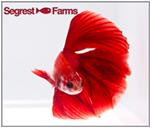We Support Project Piaba
Jan 19

Cardinal Tetras, the jewel of the Rio Negro
If you follow us closely, you will have heard or seen us mention on occasion Project Piaba . In our blog post on Environmental Sustainability in the Ornamental Fish Industry, I discussed the benefits of sustainable wild collection operations. There are several existing operations that are performing vigorous research into the best methods of collection and carefully monitoring fish populations in order to ensure they are operating sustainably. The fishery in West Hawaii, for example, is arguably the most heavily researched and monitored fishery in the world. But when I was writing the post and discussing the benefits of a sustainable fishery, Project Piaba is what I was most closely thinking about.
What is Project Piaba?
The Amazon is the most powerful river in the world. On average, the volume of water that it discharges is over five times that of the river with the second highest discharge (the Congo River) and its drainage basin is more than 70% larger. There are many smaller rivers that feed into and combine to help provide the Amazon River its massive supply of water. One such river is the Rio Negro, itself in the top ten list of volume of water discharged.
For generations, communities have made a living by catching some of the estimated 800 species of fish that call the Rio Negro home. Since the 1950’s, this has been largely the collection of ornamental species centered around Barcelos and Santa Isabel in Amazonas, Brazil. Many iconic and classic aquarium species such as Cardinal Tetras, Bleeding Heart Tetras, a wide variety of Corydoras catfish, Angelfish, Discus, Apistogramma species, and others can be found and collected in the Rio Negro.
In 1989, Dr. Ning Labbish Chao from the Universidade do Amazonas in Manaus, Brazil began the research expeditions up the Rio Negro that would become Project Piaba. Initially started to develop an ecological baseline for the fish living in the floodplain of the Rio Negro, they soon discovered the economic importance of the ornamental fish trade to the region. Since then, they have studied the impact of the ornamental fishery on the habitats and populations of the fish being studied and worked with collectors, holding facilities, and exporters to develop improved methods in order to decrease losses along the supply chain.
 - sml.jpg)
A fishing community on the Rio Negro
How the Fishery Helps the Amazon
The greatest discovery made by Project Piaba has been the degree of impact that the economic incentives of the ornamental fish trade has had on the local communities. Throughout this region, there are few opportunities to make a living, and the ornamental fish trade is providing this income for more than half of the region’s inhabitants. Without this form of income, many families would be forced to turn to environmentally devastating industries such as logging, mining, and ranching in order to survive.
But what about the fish? Surely removing them from the river will only damage their population, lead to declining numbers, and eventually cause problems by unbalancing the ecosystem of the river? Actually, this isn’t the case, and the reason lies in the annual cycles of the Rio Negro.
As with many rainforests, the Amazon experiences annual dry and wet seasons. During the wet season, the Rio Negro floods its banks, submerging huge areas of the forest. Many of the species living in the Rio Negro have developed life cycles revolving around this annual flooding. When the flood waters come in, these fish will swim into the shallower waters covering the forest floor, finding abundant food and shelter where they will spawn, hatch, and grow the next generation. As the waters recede, many of these fish fail to make it back to the main river, becoming trapped in inland pools that eventually dry up.
As with many species that have an exceptionally perilous time growing to maturity, many of these species have adapted by spawning in huge numbers. This ensures that, though millions of fish will become trapped and die when the river recedes, many will survive to return to the river and spawn the following year. The fishers target the fish that would most likely become trapped in the forest, allowing them to both collect huge numbers of fish and have a minimal impact on the overall population size. Knowing that their livelihood is intrinsically tied to the health of their fish populations, the fishers have set aside a period from May to August, coinciding with the highest water levels, in order to allow the fish spawn without human interference.
Segrest Farm’s Support of Project Piaba
One of our goals at Segrest Farms is to be the best supplier of fish in the world. In order to do so, we have to not only find the best suppliers of fish (whether captive bred or wild caught) but also ensure that our suppliers are following the best practices to ensure long-term success. As hobbyists, our passion is built on our love for these animals, and it is hypocritical to value and desire fish without also worrying about their natural populations. We neither support nor condone environmentally destructive or unsustainable practices such as the use of cyanide or overfishing.
As such, we have long been drawn to the work that Project Piaba is doing. We have had several Segrest employees, including our President, Sandy Moore, involved in acting capacities on the board of advisors of Project Piaba. While Project Piaba has done extensive work in Brazil refining the methods of the fishers and shippers, we have been able to offer our expertise in both shipping fish and how the fish will be handled and kept once they reach the United States in order to help develop holding and acclimation protocols to minimize the stress that the fish will experience upon arrival in the US.
We also believe that we need to put our money where our mouths are, so to speak. As the largest wholesale supplier in the country, we have the ability to offer these fish to retailers across the US, and every fish purchased provides income for the fisheries. This income is the lifeblood keeping these fisheries active and providing a livelihood for thousands of families across the region.
We encourage retailers to bring in and promote Project Piaba fish. Educate your customers on the value of these fish and the pivotal role they play in preserving their slice of the Amazon. We encourage hobbyists to ask their local fish stores to carry Project Piaba fish. There are precious few ways that we can directly support measures to protect and preserve the environment. Let’s take advantage of this golden opportunity.
For more information, check out our Project Piaba section or go to the official Project Piaba website.











